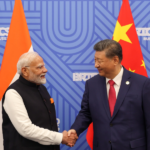
The key element in weapons procurement decisions is rarely cost or technology. More often, it is the strategic or the diplomatic factors that carry the day
By Vikas Gupta
Defence News of India, 2nd Aug 24
Weaponising a military force has never been easy. In the early 1960s the Indian Air Force (IAF) grappled with the difficult question of which fighter aircraft should equip its military. Having equipped practically the entire Indian Navy with British warships already, New Delhi opted to build the versatile MiG-21, under licence from the Soviet Union. But even then, in our earliest days as a major arms buyer, New Delhi experienced the most fundamental reality of the international arms bazaar: Which is that weapons procurement choices are rarely functions of technology or cost alone. Instead, they are most deeply anchored in foreign policy choices and strategy. More recently, this was again India’s quandary in its acquisition of medium multi-role combat aircraft. Going by combat effectiveness, price and ease of logistics, New Delhi would have probably chosen the Swedish Gripen fighter over the French Rafale. But given Paris’ greater diplomatic heft, its nuclear weapons status and technological advantage in space and nuclear power generation, Dassault’s Rafale won the contest, albeit a truncated one.
For similar reasons, the navy continues making heavy weather of buying six air-independent propulsion (AIP) submarines under its so-called Project 75-India, failing to reach a decision even after a decade of evaluation. Speak to any Indian submariner and you will hear a clear endorsement of German shipbuilder, Howaldtswerke – Deutsche Werft (HDW), whose four Type 209 (Shishumar-class) submarines have delivered yeoman service since the mid-1980s. HDW was acquired in January 2005 by German shipbuilding conglomerate, Thyssenkrupp Marine Systems (TKMS), which is poised to build the advanced Type 214 AIP submarine in strategic partnership with India’s Mazagon Dock Limited (MDL). But Germany, like Sweden, brings a low-key diplomatic approach to arms sales, which leaves Project 75-I an orphan.
The connection between arms sales, technology control, strategic alliance and industrial partnership is also highlighted in the emergence of a western democratic alliance, eponymously named AUKUS (Australia – United Kingdom – United States). AUKUS is an arrangement between only the closest of allies; two Quadrilateral partners, Japan and India, have been left out of this. The foundational pillar of AUKUS involves providing Australia with the technology partnership for building 12 nuclear-propelled, conventionally armed submarines. This scuttled what appeared to be a done deal: the Australian procurement of 12 Short-Fin Barracuda conventionally powered and armed submarines from French shipbuilder, Naval Group.
This shock decision to offer Canberra nuclear submarine technology assistance had a clear strategic aim: It was intended to nail down Australian support in the event of Chinese aggression around Taiwan. The assumption was that the Australians and Brits would fight anyway alongside the US against China. However, Australian support became apparent only after Scott Morrison became Australia’s prime minister in 2018. At that stage, the US took this bold measure to tie the Australians to the alliance. Washington wanted the US Navy to be able to count on basing out of Australia and using Australian naval facilities more seriously than anticipated earlier. It has already been announced that, before the end of 2024, the three AUKUS nations will field a new “trilateral algorithm” allowing them to share information about Chinese submarines from P-8 sonobuoys. This will be the first piece of tangible AUKUS Pillar II technology to be operationally deployed. These small capability increments are exactly the kind of synergised, forward-looking technology that the AUKUS agreement is after.
India, meanwhile, faces a simple, balance-of-power choice as it weighs its options between Ukraine on the one hand, supported by the North Atlantic Treaty Organisation (NATO) and the western democracies; and Russia on the other, supported by China and a hodgepodge of not-so-democratic countries who see in the current imbroglio an opportunity to make gains through some discreet topping-up of their weapons shopping list. Counterpoised alongside New Delhi’s untenable dependence upon Soviet/Russian weaponry (combat aircraft, medium lift helicopters, armoured fighting vehicles, air defence guns, frigates, destroyers and submarines) is an equally daunting listing of equipment from non-Russian sources: heavy airlift and light transport aircraft and helicopters, submarines, mobile air-defence guns, aerospace engines and marine gas turbines. New Delhi will have to exercise its choice in the certain conviction that propping up the Russian side comes with the certainty that China’s military and defence industry will benefit too.
There is no good option in choosing between foreign weaponry, whether China’s or Russia’s. It is for this reason that India’s ministry of defence (MoD) is pushing hard towards the goal of “atmanirbharta” (self-sufficiency). Its flagship indigenisation initiative, titled “Innovations for Defence Excellence – Defence Innovation Organisation” (iDEX-DIO), is being talked of as a game changer for the defence economy.
Established by the DIO under the MoD’s Department of Defence Production (DDP), iDEX has successfully gained momentum, fostering a burgeoning community of start-ups within the defence sector. It is currently engaged with over 400 start-ups and micro, small and medium enterprises (MSMEs). So far, procurement of 37 items, worth over Rs 2,000 crore, has been cleared.
Military development is the job of the Defence Research & Development Organisation (DRDO), which has identified nine thrust areas for focused research, namely platforms, weapon systems, strategic systems, sensors and communication systems, space, cyber security, artificial intelligence and robotics, material & devices and soldier support. These initiatives have yielded a number of state-of-the-art products including the Dhanush 155mm artillery gun, Tejas fighter, Akash surface to air missile system, Arjun tank, Dhruv light helicopter, etc An Unmanned Aerial Vehicle (UAV) has been successfully tested in fully autonomous mode. In addition, the Technology Development Fund (TDF) also funds industries up to an amount of Rs 10 crore.
The MoD has promulgated four Positive Indigenisation Lists (PILs) of defence weapons and equipment that are not permitted to be imported from abroad. The first PIL, comprising of 101 items was promulgated in August 2020, the second list of 108 items was promulgated in May 2021, the third PIL, comprising of 101 items was promulgated in April 2022 and the latest one was issued last month.
Further, more than 26,000 defence items have been uploaded on to the SRIJAN portal (an MoD initiative) and offered to private industry for indigenisation. Of these, 7,031 items have been successfully indigenised. According to the data available, defence imports have reduced from 46 per cent to 36.7 per cent since 2018-19. But the quest for “atmanirbharta” goes on.






